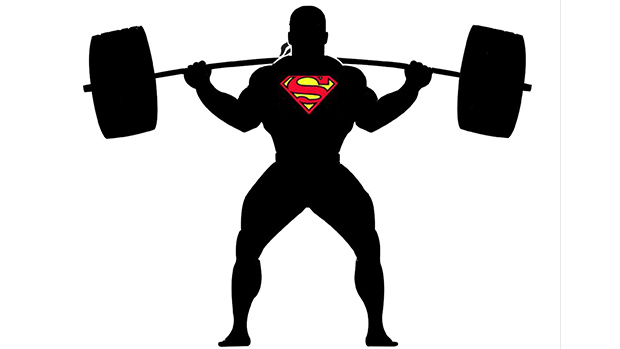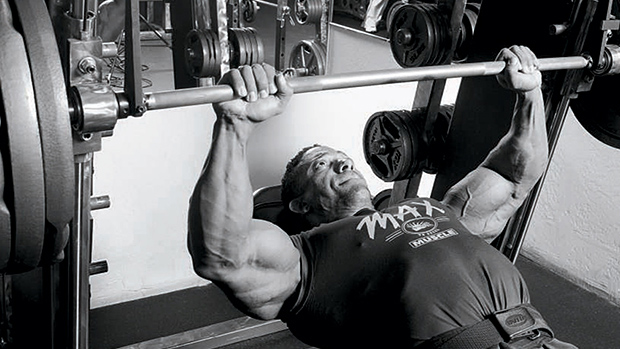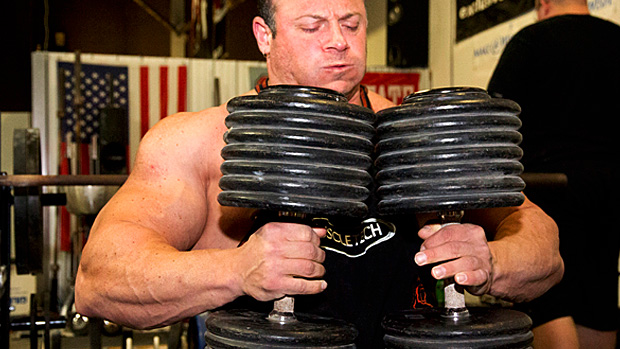Show me an athlete that has good hamstring development, and I'll show you a rarity on par with one of those two-headed gophers you see on late-night TV news, just before Letterman starts.
Good hamstrings – both from a functional and esthetic viewpoint – just aren't that common. The main reason is that athletes generally gravitate towards quad-dominant movements and do any hamstring work last (and it usually consists of a couple of sets of half-assed leg curls).
Secondly, people don't realize that the hamstrings have dual functionality. Sure they flex the lower leg, but they also extend the hips. And, again, most people, when they do work them, just concentrate on this lower-leg flexing capability (again, by doing the occasional set of leg curls).
Another problem lies in working both hamstrings simultaneously. Once I started training them independently – one leg at a time – I discovered, much to my embarrassment, that my right ham was probably 25% stronger than my left one. Amazing... and downright pathetic.
Mash all these problems together and you've got the recipe for hamstring pulls. In fact, if you take a look at the rosters of any major league baseball team or football team, you'll probably notice that many of the injuries are related to strained hammies.
Now, I ask you, do ya' think their trainers know what they're doing? Maybe, but the main problem may well be lack of equipment or lack of imagination – maybe they just haven't thought of any hamstring exercises to augment the ubiquitous leg curl.
If that's the case, or if you fall into this same category, here are a few hamstring exercises to fix what ails ya':
Sprints – Which group of athletes generally has the best-developed hammies? Bowlers? Badminton players? Nahh, not even close. Sprinters. The next time you're cruising through the channels with your remote and you see some sort of track meet being televised on ESPN2, check out the hams on those bad boy sprinters.
The reason for this development is pretty easy to understand, given that sprinting has much the same physiological action on muscles as weight training: both recruit a good degree of fast-twitch muscle, and fast-twitch muscle is what grows big the best.
For bodybuilding purposes, several "sets" of short sprints (50 to 100 yards) work best. One thing to keep in mind, though: if, after sprinting, your quads hurt a bunch more than your hams, it's probably because the strength ratio between the two isn't up to snuff. In other words, your hams are far weaker than they should be. Don't worry, though. After a few bouts of sprinting, the pain should start attacking you right where it's supposed to, just South of the keester.
For more info on sprinting and an example of a sprinting program, check out my article, The 50-Yard Dash, from Testosterone #15.
Cable curls – I certainly didn't invent cable curls for the hamstrings, but I really haven't seen anyone do them the way I do. This movement is cool because it works both functions of the hamstrings, in addition to the glutes. In fact, the first part of the movement is much like the movement used in Louie Simmons' reverse hyper machine.
(Incidentally, the Reverse Hyper would definitely have made my list if the machine were a little easier to find. You can, however, do them off a hypextension machine or even a Swiss Ball, as explained in Time to Explode, by John Paul Catanzaro.)
You simply attach one of those furry cuffs onto your ankle, attach a cable to the cuff, and face the weight stack at a slight angle. You'll also want to bend forward from the waist as much as possible (to stretch the hamstring at the hip and the knee).
Start the movement by extending the leg backwards and upwards as far as it will go. Then, when you've extended the leg all the way, continue the exercise by curling the lower leg. Bring the heel as close to your bum as possible. (Remember to do the movement at a slight angle to the weight stack; otherwise, the cable will hit your kneecap when you curl it back!) Reverse the sequence – extend the lower leg until the leg is straight and then lower the entire leg to the starting position – and begin again.
It's just extend, curl; extend, curl.



Obviously, you'll want to do both legs, unless you're a field goal kicker who doesn't give a damn whether or not his non-kicking leg is functional.
Frankenstein's Leg Curls – Sure, this revolves around the mainstay of misguided hamstring training, the leg curl, but as long as we're going to do 'em, let's make them a little tougher. This particular version of the movement was talked about in an earlier Short Topic, article, but given that they're so joyfully painful, we just had to include them in this article.
You'll do these on a conventional leg-curl machine, but thanks to a couple of techniques contributed by Charles Poliquin and Ian King, we'll make them extra-hurtful.
You'll do these one-legged, using the 1 1/3 technique. (That's where you lift the heel to the butt, pause, lower the heel 1/3rd of the way, pause, bring it back to the butt, pause, and then lower the lower leg all the way to the starting position. That's one rep.
However, you'll also need to do this one further modification: As you raise the weight, we'd like you to flex your foot "upwards" and toward the knee (toes pointed toward the knee). Then, as you begin to lower the weight, for your 1/3 of the way down rep, point your toes away from the body.
When you curl the lower leg up for the next portion of the rep, point the toes "upward" again, and when you lower the weight all the weigh down, point your toes away again.





Got that? Whenever you're raising the weight, pull your toes in toward the body, and whenever you lower the weight, point them away from the body.
As explained in other articles that have appeared in Testosterone, the gastrocnemius is one of the muscles that assist the hamstrings in flexing the lower leg toward the butt. However, by pointing the toes away from the body, we're more or less inactivating the gastrocnemius, thus making the hamstrings do all the work on the eccentric, or lowering part of the movement.
Any way you look at it, it spells ouch.
Glute/Ham Raise – While I reported on how this exercise was used by physiologists to lengthen the sarcomeres in the hamstrings and thereby reduce the incidence of hamstring injuries, strength coaches like John Davies and Dave Tate have been using them for a long time.
While there probably isn't a specific "Glute/Ham Raise Machine," you can duplicate the movement easily enough by using either one of those old-fashioned straight sit-up boards with the Velcro straps, or even the traditional family couch. Alternately, you can use sandbags, or have your training partner hold your ankles down.
You simply stand on your knees away from the anchor (either the couch or the Velcro straps), and slowly lower your body to the ground while keeping your back straight and focusing on the hamstrings. If you're like most people, you'll need to keep your hands out in front of you to catch yourself, just in case you can't do the movement and you end up kissing pavement.


If, initially, you need assistance from your hands, fine. Place them in front of you on the ground, and slowly lower yourself, just using enough pressure from your hands and arms to allow you do a slow, controlled rep.
Russian Deadlift – This is simply a "flat back" version of the stiff-legged deadlift, and I first learned of it from Ian King. However, rather than hold the barbell in your hands, you place it on your shoulders, as if you were going to do a squat (this allows for a greater range of motion, as often, in the case of stiff-legged deadlifts, you have to stop when the 45's hit the ground!).
You take a shoulder-width stance and bend the knees slightly (don't change the angle of the knees during the movement, and don't let the angle exceed 25 degrees). Bend forward at the waist, and keep the chest up and the hips and spine aligned. Bend forward until your spine starts to round out.


Ian also recommends pushing the butt back and allowing the weight to drift to your heels during the movement. Additionally, squeeze the glutes on the way up to accentuate hamstring involvement.
Good mornings – These are very similar to the Russian Deadlifts, but instead of keeping the back flat and aligned with the hips, you'll bend forward as far as you can by rounding out the spine. If you can bend all the way down, stick your head between your legs and say, "Howdy," we'll all be duly impressed.


Be careful about the weight you choose, though. Start out very light and work your way up. And, as mentioned in the description for Russian Deadlifts, push the butt back and allow the weight to drift to your heels during the movement. And, likewise, squeeze the glutes on the way up.
Step-ups – This movement is typically considered to be a quad movement, but because it involves extending the hip, it's also good for hamstring development.
You simply place a barbell on your shoulders and stand next to a box or platform and place your right foot on top of the box, near the edge. Leave it there. Using that same foot/leg, push off and raise the entire body until the knee is almost straight (don't lock out).
And avoid the impulse to use your left leg to jump up. Let the muscles of the right leg do all the work without giving it any kind of plyometric kick in the pants. Then, lower yourself slowly – don't drop like a duck that's been shot out of the sky. Repeat with the other leg (did I really need to add that?).


Obviously, the height of the box (and the poundage you use) determines how hard the movement is. I have a box in my garage made of two-by-fours and plywood sheets. When I'm ready to graduate to a higher box, I simply use additional boards and sheets as needed.
As a final note on this movement, and contrary to accepted hamstring-training dogma, I usually use a high number of reps. In fact, I often prefer to time myself, doing as many as I can in a two minute period. Alternately, I'll sometimes do sets using extremely slow-tempos on the eccentric portion of the movement (usually 10 seconds or so per rep) for sets of 10.
High-heeled Leg Press – This one will require that you go into your wife's closet when she's out shopping and fish out a pair of red pumps. Nahh, I call them "high-heeled" because doing the movement requires you to put your feet up very high on the leg press platform and push through your heels as you do your leg presses. In fact, if possible, hang the toes over the top edge of the platform.
The extreme angle will cause the hamstrings to fire preferentially over the quads. As with conventional leg presses, lower the platform as far as possible, i.e., until your hips start to rise off the seat.
Bizzaro Stairwalking – Let me preface this one my saying that this technique isn't going to build humogous legs. It will, however, in the long run, contribute to overall hamstring strength and functionality, and that ain't bad.
All it involves is walking up the stairs completely backwards, thereby causing the hamstrings to do the bulk of the work, as opposed to the quadriceps.
Similarly, walk backwards when you walk down the stairs.
Simply do this during the course of the day whenever you have to tackle a flight of stairs, unless, of course, you give a damn what your co-workers think.
One word of caution: Always use the handrail, and if you do this at home, make sure the stairs are relatively free of skates, Hot Wheels, or marbles.
A few words in general about hamstring training
• Do relatively low reps – under 8, and instead opt for multiple sets.
• Think about training one leg at a time.
• Emphasize the eccentric portion of the movement to stretch the sarcomeres and thereby prevent future injuries.
• Stretch those mothers. They're the longest muscles in the body (unless you're Lee Priest, in which case they're wee little things), so when they tighten up even a little bit, you feel it.
• Devote an entire workout to hamstrings, instead of lumping a few movements on after your quad workout.
Above all, keep variety in your hamstring training. Do multiple movements. I like what Charles Staley once said about the subject (and I'm probably paraphrasing a bit here), "If you're a piano player, and you just practice playing one song every day for a year, you'll be damn good at playing that particular song, but you won't be much good at playing anything else."




